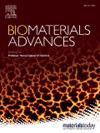探索生物活性骨水泥膏体:骨科手术的一个有前途的解决方案
IF 6
2区 医学
Q2 MATERIALS SCIENCE, BIOMATERIALS
Materials Science & Engineering C-Materials for Biological Applications
Pub Date : 2025-07-15
DOI:10.1016/j.bioadv.2025.214416
引用次数: 0
摘要
骨水泥是一种生物材料,已在骨科手术中有效应用了近50年。水泥在缺陷部位注射后硬化,不需要任何外部助剂。骨水泥通常用于种植体固定、关节置换术、创伤手术、骨质疏松症治疗和抗生素输送。由于患者的骨骼解剖结构不同,骨水泥在体内的最终硬化纠正了植入物与骨骼之间的异常和间隙。最普遍的可注射骨水泥是基于陶瓷或聚合物化合物。陶瓷水泥的化学成分与骨相似,通过化学反应硬化,而聚合促进聚合物基骨水泥硬化。尽管骨水泥在骨科手术中取得了重大进展,但必须承认其局限性和伴随的注意事项。长期降解可能导致植入物松动和硬化过程中的放热反应,导致组织坏死。为了解决这些限制,人们不断地评估各种方法。本文综述的主要目的是综合评价陶瓷和聚合物基骨水泥在骨科手术中的应用前景。充分的知识可以导致归纳策略,以提高骨水泥的性能。本文章由计算机程序翻译,如有差异,请以英文原文为准。

Exploring bioactive bone cement pastes: A promising solution for orthopedic surgeries
Bone cement is a biomaterial that has been used effectively in orthopedic surgery for almost 50 years. The cement hardens after injection in the defect site without needing any external agent. Bone cement is commonly used in implant fixation, joint replacement, trauma surgery, osteoporosis management, and antibiotic delivery. Since the bone anatomy of patients is different, the final hardening of bone cement in the body corrects the abnormalities and gaps between the implant and the bone. The most universal injectable bone cements are based on ceramic or polymer compounds. The chemical composition of ceramic cement is similar to that of bone and hardens by chemical reaction, while polymerization promotes hardening in polymer-based bone cement. Despite the significant progress of bone cement in orthopedic surgery, its limitations and accompanying considerations must be acknowledged. Long-term degradation potentially leads to loosening of the implant and an exothermic reaction during hardening, leading to tissue necrosis. To address these limitations various approaches have been continuously evaluated. The major objective of this review is to comprehensively evaluate ceramic and polymer-based bone cement as a promising approach in orthopedic surgery. Adequate knowledge can lead to the induction of strategies to improve the performance of bone cement.
求助全文
通过发布文献求助,成功后即可免费获取论文全文。
去求助
来源期刊
CiteScore
17.80
自引率
0.00%
发文量
501
审稿时长
27 days
期刊介绍:
Biomaterials Advances, previously known as Materials Science and Engineering: C-Materials for Biological Applications (P-ISSN: 0928-4931, E-ISSN: 1873-0191). Includes topics at the interface of the biomedical sciences and materials engineering. These topics include:
• Bioinspired and biomimetic materials for medical applications
• Materials of biological origin for medical applications
• Materials for "active" medical applications
• Self-assembling and self-healing materials for medical applications
• "Smart" (i.e., stimulus-response) materials for medical applications
• Ceramic, metallic, polymeric, and composite materials for medical applications
• Materials for in vivo sensing
• Materials for in vivo imaging
• Materials for delivery of pharmacologic agents and vaccines
• Novel approaches for characterizing and modeling materials for medical applications
Manuscripts on biological topics without a materials science component, or manuscripts on materials science without biological applications, will not be considered for publication in Materials Science and Engineering C. New submissions are first assessed for language, scope and originality (plagiarism check) and can be desk rejected before review if they need English language improvements, are out of scope or present excessive duplication with published sources.
Biomaterials Advances sits within Elsevier''s biomaterials science portfolio alongside Biomaterials, Materials Today Bio and Biomaterials and Biosystems. As part of the broader Materials Today family, Biomaterials Advances offers authors rigorous peer review, rapid decisions, and high visibility. We look forward to receiving your submissions!

 求助内容:
求助内容: 应助结果提醒方式:
应助结果提醒方式:


